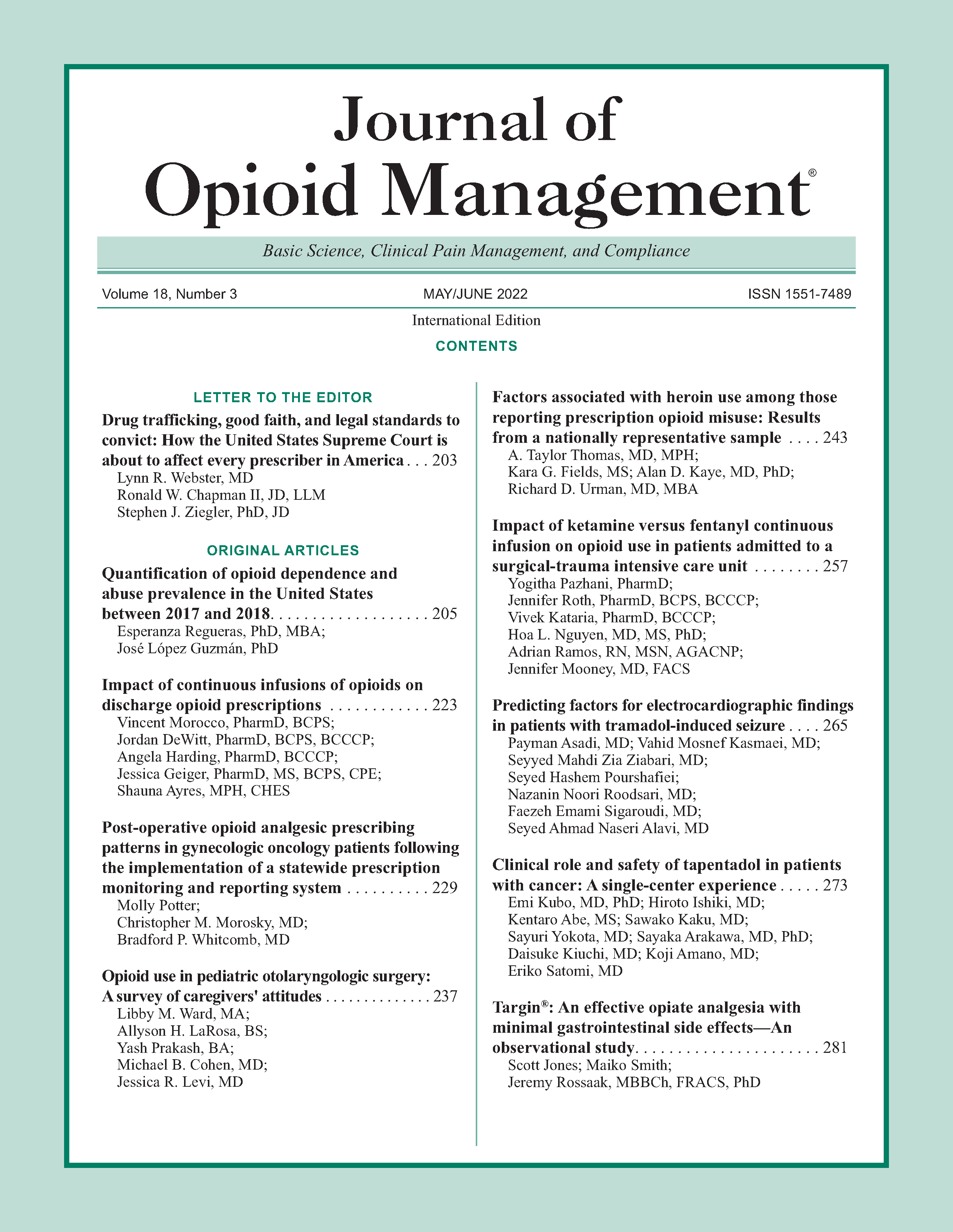Quantification of opioid dependence and abuse prevalence in the United States between 2017 and 2018
DOI:
https://doi.org/10.5055/jom.2022.0712Keywords:
opioids, epidemic, pain reliever, abuse, dependenceAbstract
Objectives: To quantify the prevalence of opioid drug dependence and abuse in United States between 2017 and 2018 and identify which opioid molecules are associated with a higher level of dependence and abuse.
Design: National Survey on Drug Use and Health (NSDUH) data for 2017 and 2018 have been extracted. The variables related to painkillers were studied, the most important ones were selected, and several variable crosses were made. After the data were extracted, they were analyzed using Microsoft Excel and PivotTables, calculating the relative prevalence and percentages of patients with abuse and dependence.
Results: In total, 1.4 million people had dependence on pain relievers (PRs) in 2018. The last PR used was mostly hydrocodone (33 percent) and oxycodone (24 percent). The main reasons for using a PR without a doctor's prescription were relieving pain (48 percent), feel good (16 percent), and relax or relieve tension (15 percent). Among patients who used a PR with a medical prescription, 1.5 million used it more frequently than prescribed, 1.2 million used it longer than prescribed, and 1.9 million used it in higher amounts than prescribed.
Conclusions: Abuse and dependence to PRs is lower than expected with over 1.4 million people in the United States having dependence in 2018 (0.6 percent point prevalence). Most cases of dependence are associated with misuse or abuse of prescriptions without medical supervision or the use of medications without a prescription of their own. Oxycodone and hydrocodone are the molecules most associated with dependence, misuse, abuse, and use without prescription. The age of onset of oxycodone misuse is very early (14 years old). Fentanyl does not seem relevant in any of the variables studied.
References
Mark Edmund R: Are prescription opioids driving the opioid crisis? Assumptions vs facts. Pain Med. 2018; 19: 793-807.
Substance Abuse and Mental Health Services Administration (SAMHSA): PDAS public online data analysis, survey national survey on drug use and health 2017 and 2018. Available at https://www.samhsa.gov/data/report/2018-nsduh-detailedtables. Accessed June 18, 2020.
SAMHSA PDAS NSDUH: National survey on drug use ND health (NSDUH). 2017. Available at https://www.samhsa.gov/data/report/2017-nsduh-detailed-tables. Accessed June 18, 2020.
SAMHSA PDAS NSDUH: National survey on drug use nd health (NSDUH). 2018. Available at https://www.samhsa.gov/data/report/2018-nsduh-detailed-tables. Accessed June 18, 2020.
SAMHSA: Results from the 2010 National Survey on Drug Use and Health: Summary of National Findings, NSDUH Series H-41, HHS Publication No. (SMA) 11-4658. Rockville, MD: Substance Abuse and Mental Health Services Administration, 2011.
Florence CS, Zhou C, Luo F, et al.: The economic burden of prescription opioid overdose, abuse, and dependence in the United States, 2013. Med Care. 2016; 54(10): 901-906.
Imtiaz S, Shiedl KD, Fischer B, et al.: Harms of prescription opioid use in the United States. Subst Abuse Treat Prev Policy. 2014; 27: 9-43.
SAMHSA: The national survey on drug use and health: 2019. 2019. Available at https://www.samhsa.gov/data/report/dr-elinore-f-mccance-katz-webcast-slides-national-2019. Accessed January 5, 2021.
AEMPS Agencia Española de Medicamentos y Productos Sanitarios: Agencia española de medicamentos y productos sanitarios AEMPS. [Publicación en línea] «Fentanilo de liberación inmediata: Importancia de respetar las condiciones de uso autorizadas».
: 1-4. Available at https://www.aemps.gob.es/informa/notas-Informativas/medicamentosUsoHumano/seguridad/2018/docs/NI_MUH_FV-5_2018-Fentanilo.pdf. Accessed May 2019.
Vosburg SK, Ssdrctkspm GJ: Assessment of tapentadol API abuse liability with the researched abuse, diversion and addiction-related surveillance system. J Pain. 2018; 19(4): 439-453.
Rose M: Are prescription opioids driving the opioid crisis? Assumptions vs facts. Pain Med. 2018; 19: 793-807.
Stonington S, Coffa D: Structura iatrogenesis—A 43-year-old man with “opioid misuse.” N Eng J Med. 2019; 21: 380.
Published
How to Cite
Issue
Section
License
Copyright 2005-2025, Weston Medical Publishing, LLC and Journal of Opioid Management. All Rights Reserved.











